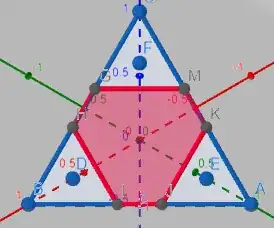I've tried to formulate my question in a previous topic but I terribly messed up my formulation, so I will create a new question to avoid any confusion.
What I'm looking for is the distribution of the maximum gap between two points when I have drawn $n$ samples of iid uniform variates. A "correct" formalized form of the question I have would be the following :
Let $n \geq 2$ be an integer, $a<b$ two real numbers, $X_1, ..., X_n$ be iid $\sim \mathcal{U}([a,b])$ and $X_{(1)}, ..., X_{(n)}$ the corresponding ordered statistics with $X_{(1)} \leq ... \leq X_{(n)}$. For some $\delta \in [0, b-a]$, what would be the value of $$\mathbb{P}\left(\underset{0\leq k \leq n}{\max} \left(X_{(k+1)}-X_{(k)}\right) \leq \delta \right)$$ with the convention $X_{(0)} = a$ and $X_{(n+1)} = b$.
Reducing to the case $a=0$ and $b=1$ :
I know from this wikipedia page that $X_{(k)} \sim Beta(k, n+1-k)$ and that $X_{(k+1)}-X_{(k)} \sim Beta(1, n)$.
This makes the distribution of $X_{(n+1)}-X_{(n)}$ and $X_{(1)}-X_{(0)}$ rather simple to compute with the convention. However it doesn't help me for the maximum as there is no independence.
I found a beginning of answer in the Distribution of maximum gap between points topic. However the answer is incomplete as it mainly is a rewriting of the value as $$\mathbb{P}\left(\underset{0\leq k \leq n}{\max} \left(X_{(k+1)}-X_{(k)}\right) \leq \delta \right) = \mathbb{P}\left(X_{(1)}-X_{(0)} \leq \delta, ..., X_{(n+1)}-X_{(n)} \leq \delta\right)$$
For now I think I will try to brute force with some conditional probabilities, I'll see where it goes. Would anyone have an answer that goes further in the resolution, or another idea on how to deal with this problem ?
EDIT 1 : My brute force method led me to $$\mathbb{P}\left(\underset{0\leq k \leq n}{\max} \left(X_{(k+1)}-X_{(k)}\right) \leq \delta \right) \\ = \\ (1-(1-\delta)^n)^n \cdot \mathbb{P}\left(X_{(1)}\leq \delta | X_{(2)}-X_{(1)}\leq \delta, ..., 1-X_{(n)}\leq \delta \right)$$ However I still don't know how to proceed with that last term.
EDIT 2 : Kimchi lover suggested a very interesting geometric approach before deleting their answer. They pointed that the random vector $\left(X_{(1)}-X_{(0)} , ..., X_{(n+1)}-X_{(n)}\right)$ follows the Dirichelet distribution $D(1, ..., 1)$, therefore giving it a constant density over the $n$-simplex - by noting $\lambda_n$ the $n$-dimensional Lebesgue measure and $\Delta(\delta)$ the set $\{x \in [0,1]^{n+1} : \|x\|_1=1, ~ x_i \leq \delta ~\forall 1\leq i \leq n+1\}$, aforementioned density would be $1/\lambda_n(\Delta(1))$. We now "only" need to compute the size of $\Delta(\delta)$ to then normalize it by $\Delta(1)$.
From here I made a drawing - using GeoGebra 3D - of the case $n=2$, $\delta = 0.6$ (left) and $\delta = 0.4$ (right) to get some intuition :
From here I understand there is a critical point at $\delta = 0.5$ as the outer triangles (or $n$-simplex should I say) start to overlap.
To go further I will here stick with the case $\delta \geq 0.5$ :
I understand that I have $n+1$ smaller $n$-simplex with side length $\sqrt{2}(1-\delta)$, therefore giving each of them (cf. https://en.wikipedia.org/wiki/Simplex#Volume) a size of $(\sqrt{2}(1-\delta))^n\frac{\sqrt{n+1}}{\sqrt{2^n}n!}$.
Thus $\Delta(\delta) = \underbrace{(\sqrt{2})^n\frac{\sqrt{n+1}}{\sqrt{2^n}n!}}_{\Delta(1)} - (n+1)(\sqrt{2}(1-\delta))^n\frac{\sqrt{n+1}}{\sqrt{2^n}n!}$.
As such, for $\delta \geq 0.5$ I have : $$\frac{\Delta(\delta)}{\Delta(1)} = 1-(n+1)(1-\delta)^n $$
I will now work on the case $\delta \leq 0.5$, I'd be grateful for any suggestion you might have for it.
EDIT 3 : Following MathSensei's recommendation I looked into formulas for the hyper-area of the intersection between the hypercube $[0,\delta]^{n+1}$ and the hyperplane $\{x\in\mathbb{R}^{n+1} ~:~ \|x\|_1 = 1\}$ when $1/(n+1) \leq \delta \leq 1$.
I found out on the topic Area of the intersection between a hypercube and a hyperplane that the Irwin-Hall distribution has a pdf that corresponds to a very similar version of the problem as it represents the area of the intersection between the hypercube $[0,1]^{n+1}$ and the hyperplane $\{x\in\mathbb{R}^{n+1} ~:~ \|x\|_1 = t\}$. Said pdf is $f(t) = \sum_{i=0}^{n+1} (-1)^i \frac{(n+1)!}{i!(n+1-i)!}\frac{(t-i)^n}{n!}1_{t>i}$.
I naively tried to convert to my problem by multiplying an Irwin-Hall variate $T$ of parameter $n+1$ by $\delta$ to get a new variate $Y = \delta T$ and the equivalent of my hypercube $[0,\delta]^{n+1}$. Its cdf is $F_Y(t) = \mathbb{P}(\delta T \leq t) = \mathbb{P}(T \leq t/\delta) = F_T(t/\delta)$, thus its pdf is $f_Y(x) = f_T(x/\delta)/\delta$.
From here I tried plugging in $x=1$ thinking I would still have that equivalent of intersection with the hyperplane I want and the hypercube, but turns out I'm wrong.
From here I looked for a geometrical proof of the Irwin-Hall pdf that I found for Theorem 1 of section 2 in A geometric derivation of the Irwin-Hall Distribution, Marengo et al. 2017 however I am pretty lost with the $B_j(t)$, especially since I do not want to exclude when coordinates are $>1$ but when they are $>\delta$. I know I would have $t=1$ but they lost me when computing the volume of the intersection of $B_j(t)$.

